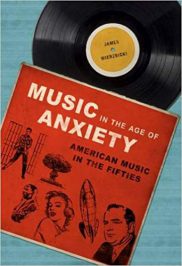What may come to mind first when we think about the music of the 1950s in the US are probably the styles of Rock’n’Roll, Doo Wop and Rhythm and Blues.
Wierzbicki however, in his study points to the many other musical forms that evolved in that decade, since changes and developments in American politics, society, to name but two fields, had a great impact on popular music, jazz, movie soundtracks, opera, Broadway, modernistic music, classical mainstream and avantgarde music.
 In nine chapters, he elaborates on these styles, and the way they were heavily influenced by the cold war distrust, anxiety and fear of atomic bombs.
In nine chapters, he elaborates on these styles, and the way they were heavily influenced by the cold war distrust, anxiety and fear of atomic bombs.
“What these various types of music do have in common is the fact that all of them sprang up in a particular cultural environment, an environment identified by a set of attitudes and conditions that in American history seems to have been quite unique. All of this music, I suggest, was somehow affected by the anxious spirit of the times; the period’s zeitgeist thus haunts the book.”
The origins of the enormous changes in US society in the 1950s go way back to the early 1940s and one thing that is often neglected when looking back at the (social side) of the 1950s is the sense of a strong fixation on sex, on a national level with commercials, innocent but somewhat meaningful song lyrics and even sitcom dialogues full of allusions to sex anywhere in the musical and entertainment mainstream. However, uttered and communicated in a society that offered hardly any outlets for it either on the male or the female side (before a proper marriage). The early 1950s were a period of sexual hang-ups, concludes Wierzbicki.
Since in the American media of the time the very subject of sex simultaneously was nonexistent, even though social standards were all focused on preparing the male and female teenager for marriage, which was broadly considered as the only possible relationship between men and women. “Nor did experts of the 1950s see a relationship between purely sexual anxieties and anxieties of a more general sort triggered by widespread fear of nuclear holocaust and America’s infiltration by communists.”
Those omnipresent but never publicly discussed or admitted anxieties moreover had severe consequences for composer, conductors, producers, directors, arrangers or singers who were free spirits and could be located politically somewhere slightly left from the average Democrat. For the individual this could easily result in a prison term, the loss of employment and social isolation. This was also a dangerous period for artists who were either gay, came from communist countries or who for no reason at all were accused of furthering pro-Russian propaganda because of their scripts, articles, motion pictures, novels, paintings or music they produced.
Many recent movies with a 1950s setting deal with those problems and, as Wierzbicki points out, show how this anxiety took over large sections of everyday American life; while seemingly, the prosperous 1950s in the US were a decade of consumerism only.
Even so, that urge to purchase and possess was always accompanied by a fear of atomic warfare (real), and the fear of Soviet spies, anti-government conspiracies and even alien invasions from outer space (mostly imagined).
Music in the Age of Anxiety with nearly 300 pages is a rather concise work, considering that merely 20 pages must suffice to describe and briefly analyze each of the nine different musical styles and their development in that decade. Thereby always demonstrating what exactly distinguishes them from the “musical mainstream” of the time and how in retrospect the individual kinds can be evaluated (as either conservative, cautious, new, visionary or rebellious).
As a result of so many topics, the depth of the individual essays is limited. Nevertheless, the chapters on “Hollywood” and “Broadway” are first class. And since most works on the decade’s music present just a single musical style, this book should be of excellent use for students or readers who want a brief overview.
James Wierzbicki is a teacher of musicology at the University of Sydney.
Review by Dr. A. Ebert © 2017
James Wierzbicki. Music in the Age of Anxiety: American Music in the Fifties (Music in American Life). University of Illinois Press, 2016, 297 p.
